ANSYS Fluent Getting Started Guide
ANSYS, Inc.
Southpointe
2600 ANSYS Drive
Canonsburg, PA 15317
ansysinfo@ansys.com
http://www.ansys.com
(T) 724-746-3304
(F) 724-514-9494
Release 18.0
January 2017
ANSYS, Inc. and
ANSYS Europe,
Ltd. are UL
registered ISO
9001: 2008
companies.
�
Copyright and Trademark Information
© 2016 SAS IP, Inc. Unauthorized use, distribution or duplication is prohibited.
ANSYS, ANSYS Workbench, Ansoft, AUTODYN, EKM, Engineering Knowledge Manager, CFX, FLUENT, HFSS, AIM
and any and all ANSYS, Inc. brand, product, service and feature names, logos and slogans are registered trademarks
or trademarks of ANSYS, Inc. or its subsidiaries in the United States or other countries. ICEM CFD is a trademark
used by ANSYS, Inc. under license. CFX is a trademark of Sony Corporation in Japan. All other brand, product,
service and feature names or trademarks are the property of their respective owners.
Disclaimer Notice
THIS ANSYS SOFTWARE PRODUCT AND PROGRAM DOCUMENTATION INCLUDE TRADE SECRETS AND ARE CONFID-
ENTIAL AND PROPRIETARY PRODUCTS OF ANSYS, INC., ITS SUBSIDIARIES, OR LICENSORS. The software products
and documentation are furnished by ANSYS, Inc., its subsidiaries, or affiliates under a software license agreement
that contains provisions concerning non-disclosure, copying, length and nature of use, compliance with exporting
laws, warranties, disclaimers, limitations of liability, and remedies, and other provisions. The software products
and documentation may be used, disclosed, transferred, or copied only in accordance with the terms and conditions
of that software license agreement.
ANSYS, Inc. and ANSYS Europe, Ltd. are UL registered ISO 9001: 2008 companies.
U.S. Government Rights
For U.S. Government users, except as specifically granted by the ANSYS, Inc. software license agreement, the use,
duplication, or disclosure by the United States Government is subject to restrictions stated in the ANSYS, Inc.
software license agreement and FAR 12.212 (for non-DOD licenses).
Third-Party Software
See the legal information in the product help files for the complete Legal Notice for ANSYS proprietary software
and third-party software. If you are unable to access the Legal Notice, Contact ANSYS, Inc.
Published in the U.S.A.
�
Table of Contents
Preface ......................................................................................................................................................... v
1. The Contents of This Manual ................................................................................................................ v
2. The Contents of the Fluent Manuals ..................................................................................................... v
3. Technical Support .............................................................................................................................. vii
1. Introduction to ANSYS Fluent ................................................................................................................. 1
1.1. Program Capabilities ......................................................................................................................... 4
1.2. ANSYS Fluent Documentation ........................................................................................................... 5
1.2.1. Accessing the Documentation Files Using the ANSYS Help Viewer ............................................. 5
1.2.2. Accessing the PDF Documentation ........................................................................................... 6
1.2.2.1. Downloading and Extracting the PDF Documentation Files .............................................. 7
1.2.2.2. Navigating the PDF Files .................................................................................................. 7
1.2.2.3. Printing the PDF Files ....................................................................................................... 7
1.3. Known Limitations in ANSYS Fluent 18.0 ........................................................................................... 7
2. Basic Steps for CFD Analysis using ANSYS Fluent ................................................................................. 17
2.1. Steps in Solving Your CFD Problem .................................................................................................. 17
2.2. Planning Your CFD Analysis ............................................................................................................. 17
3. Guide to a Successful Simulation Using ANSYS Fluent ......................................................................... 23
4. Starting and Executing ANSYS Fluent ................................................................................................... 25
4.1. Starting ANSYS Fluent ..................................................................................................................... 25
4.1.1. Starting ANSYS Fluent Using Fluent Launcher ......................................................................... 25
4.1.1.1. Setting General Options in Fluent Launcher ................................................................... 27
4.1.1.2. Single-Precision and Double-Precision Solvers ................................................................ 29
4.1.1.3. Setting Parallel Options in Fluent Launcher .................................................................... 30
4.1.1.4. Setting Remote Options in Fluent Launcher ................................................................... 32
4.1.1.5. Setting Scheduler Options in Fluent Launcher ................................................................ 33
4.1.1.6. Setting Environment Options in Fluent Launcher ........................................................... 34
4.1.2. Starting ANSYS Fluent on a Windows System .......................................................................... 36
4.1.3. Starting ANSYS Fluent on a Linux System ................................................................................ 37
4.1.4. Command Line Startup Options ............................................................................................. 37
4.1.4.1. ACT Option ................................................................................................................... 39
4.1.4.2. Graphics Options ........................................................................................................... 39
4.1.4.3. Meshing Mode Option ................................................................................................... 40
4.1.4.4. Performance Options ..................................................................................................... 40
4.1.4.5. Parallel Options ............................................................................................................. 40
4.1.4.6. Postprocessing Option .................................................................................................. 41
4.1.4.7. SGE Options .................................................................................................................. 41
4.1.4.8. LSF Option .................................................................................................................... 42
4.1.4.9. Version and Release Options .......................................................................................... 42
4.1.4.10. System Coupling Options ............................................................................................ 42
4.1.4.11. Other Startup Options ................................................................................................. 43
4.2. Running ANSYS Fluent in Batch Mode ............................................................................................. 43
4.2.1. Background Execution on Linux Systems ................................................................................ 43
4.2.2. Background Execution on Windows Systems .......................................................................... 44
4.2.3. Batch Execution Options ........................................................................................................ 45
4.3. Switching Between Meshing and Solution Modes ............................................................................ 47
4.4. Checkpointing an ANSYS Fluent Simulation ..................................................................................... 47
4.5. Cleaning Up Processes From an ANSYS Fluent Simulation ................................................................ 48
4.6. Exiting ANSYS Fluent ...................................................................................................................... 49
Glossary of Terms ........................................................................................................................................ 51
Release 18.0 - © SAS IP, Inc. All rights reserved. - Contains proprietary and confidential information
of ANSYS, Inc. and its subsidiaries and affiliates.
iii
�
iv
Release 18.0 - © SAS IP, Inc. All rights reserved. - Contains proprietary and confidential information
of ANSYS, Inc. and its subsidiaries and affiliates.
�
Preface
This preface is divided into the following sections:
1.The Contents of This Manual
2.The Contents of the Fluent Manuals
3.Technical Support
1.The Contents of This Manual
The ANSYS Fluent Getting Started Guide highlights some of the features in ANSYS Fluent and how to
get started using the software.
A brief description of what is in each chapter follows:
•
Introduction to ANSYS Fluent (p. 1), provides an overview of the capabilities of ANSYS Fluent and details
about the available documentation.
• Basic Steps for CFD Analysis using ANSYS Fluent (p. 17), describes the steps involved in solving a CFD
problem and questions to consider.
• Guide to a Successful Simulation Using ANSYS Fluent (p. 23), provides specific guidelines that help ensure
your CFD simulation is a success.
• Starting and Executing ANSYS Fluent (p. 25), describes options and alternatives to starting, running, and
exiting ANSYS Fluent. It also provides instructions for remote execution and batch execution.
• Glossary of Terms (p. 51), contains a listing of terms commonly used throughout the documentation.
2.The Contents of the Fluent Manuals
The manuals listed below form the Fluent product documentation set. They include descriptions of the
procedures, commands, and theoretical details needed to use Fluent products.
• Fluent Getting Started Guide contains general information about getting started with using
Fluent and provides details about starting, running, and exiting the program.
• Fluent Migration Manual contains information about transitioning from the previous release of Fluent,
including details about new features, output changes, and text command list changes.
• Fluent User's Guide contains detailed information about running a simulation using the solution
mode of Fluent, including information about the user interface, reading and writing files, defining
boundary conditions, setting up physical models, calculating a solution, and analyzing your results.
• ANSYS Fluent Meshing Migration Manual contains information about transitioning from the previous
release of Fluent Meshing, including descriptions of new features and text command list changes.
• ANSYS Fluent Meshing User's Guide contains detailed information about creating 3D meshes
using the meshing mode of Fluent.
Related video help on meshing can be found on the ANSYS How To Videos page.
• Fluent in Workbench User's Guide contains information about getting started with and using Fluent
within the Workbench environment.
Release 18.0 - © SAS IP, Inc. All rights reserved. - Contains proprietary and confidential information
of ANSYS, Inc. and its subsidiaries and affiliates.
v
�
Preface
• Fluent Theory Guide contains reference information for how the physical models are implemented in
Fluent.
• Fluent Customization Manual contains information about writing and using user-defined functions
(UDFs).
• Fluent Tutorial Guide contains a number of examples of various flow problems with detailed instructions,
commentary, and postprocessing of results.
The latest updates of the ANSYS Fluent tutorials are available on the ANSYS Customer Portal. To
access tutorials and their input files on the ANSYS Customer Portal, go to http://support.ansys.com/
training.
• The latest updates of the ANSYS Fluent Meshing tutorials are available on the ANSYS Customer
Portal. To access tutorials and their input files on the ANSYS Customer Portal, go to http://sup-
port.ansys.com/training.
• Fluent Text Command List contains a brief description of each of the commands in Fluent’s solution
mode text interface.
• ANSYS Fluent Meshing Text Command List contains a brief description of each of the commands in
Fluent’s meshing mode text interface.
• ANSYS Fluent Advanced Add-On Modules contains information about the usage of the different advanced
Fluent add-on modules, which are applicable for specific modeling needs.
– Part I: ANSYS Fluent Adjoint Solver contains information about the background and usage of Fluent's
Adjoint Solver Module that allows you to obtain detailed sensitivity data for the performance of a
fluid system.
– Part II: ANSYS Fluent Battery Module contains information about the background and usage of Fluent's
Battery Module that allows you to analyze the behavior of electric batteries.
– Part III: ANSYS Fluent Continuous Fiber Module contains information about the background and usage
of Fluent's Continuous Fiber Module that allows you to analyze the behavior of fiber flow, fiber
properties, and coupling between fibers and the surrounding fluid due to the strong interaction that
exists between the fibers and the surrounding gas.
– Part V: ANSYS Fluent Fuel Cell Modules contains information about the background and the usage
of two separate add-on fuel cell models for Fluent that allow you to model polymer electrolyte
membrane fuel cells (PEMFC), solid oxide fuel cells (SOFC), and electrolysis with Fluent.
– Part VI: ANSYS Fluent Magnetohydrodynamics (MHD) Module contains information about the back-
ground and usage of Fluent's Magnetohydrodynamics (MHD) Module that allows you to analyze the
behavior of electrically conducting fluid flow under the influence of constant (DC) or oscillating (AC)
electromagnetic fields.
– Part VII: ANSYS Fluent Population Balance Module contains information about the background and
usage of Fluent's Population Balance Module that allows you to analyze multiphase flows involving
size distributions where particle population (as well as momentum, mass, and energy) require a balance
equation.
• Fluent as a Server User's Guide contains information about the usage of Fluent as a Server which allows
you to connect to a Fluent session and issue commands from a remote client application.
vi
Release 18.0 - © SAS IP, Inc. All rights reserved. - Contains proprietary and confidential information
of ANSYS, Inc. and its subsidiaries and affiliates.
�
Technical Support
• Running ANSYS Fluent Using a Load Manager contains information about using third-party load managers
with ANSYS Fluent.
– Part I: Running ANSYS Fluent Under LSF contains information about using Fluent with Platform
Computing’s LSF software, a distributed computing resource management tool.
– Part II: Running ANSYS Fluent Under PBS Professional contains information about using Fluent with
Altair PBS Professional, an open workload management tool for local and distributed environments.
– Part III: Running ANSYS Fluent Under SGE contains information about using Fluent with Univa Grid
Engine (formerly Sun Grid Engine) software, a distributed computing resource management tool.
Related video help for Fluent can be found on the ANSYS How To Videos page.
3.Technical Support
If you encounter difficulties while using ANSYS Fluent, please first refer to the section(s) of the manual
containing information on the commands you are trying to use or the type of problem you are trying
to solve. The product documentation is available from the online help, or from the ANSYS Customer
Portal. To access documentation files on the ANSYS Customer Portal, go to http://support.ansys.com/
documentation.
If you encounter an error, please write down the exact error message that appeared and note as much
information as you can about what you were doing in ANSYS Fluent.
Technical Support for ANSYS, Inc. products is provided either by ANSYS, Inc. directly or by one of our
certified ANSYS Support Providers. Please check with the ANSYS Support Coordinator (ASC) at your
company to determine who provides support for your company, or go to www.ansys.com and select
Contacts> Contacts and Locations.
If your support is provided by ANSYS, Inc. directly, Technical Support can be accessed quickly and effi-
ciently from the ANSYS Customer Portal, which is available from the ANSYS Website (www.ansys.com)
under Support > Customer Portal. The direct URL is: support.ansys.com.
One of the many useful features of the Customer Portal is the Knowledge Resources Search, which can
be found on the Home page of the Customer Portal. To use this feature, enter relevant text (error
message, etc.) in the Knowledge Resources Search box and click the magnifying glass icon. These
Knowledge Resources provide solutions and guidance on how to resolve installation and licensing issues
quickly.
NORTH AMERICA
All ANSYS Products except Esterel, Apache and Reaction Design products
Web: Go to the ANSYS Customer Portal (http://support.ansys.com) and select the appropriate option.
Toll-Free Telephone: 1.800.711.7199 (Please have your Customer or Contact ID ready.)
Support for University customers is provided only through the ANSYS Customer Portal.
GERMANY
ANSYS Mechanical Products
Telephone: +49 (0) 8092 7005-55 (CADFEM)
Email: support@cadfem.de
Release 18.0 - © SAS IP, Inc. All rights reserved. - Contains proprietary and confidential information
of ANSYS, Inc. and its subsidiaries and affiliates.
vii
�
Preface
All ANSYS Products
Web: Go to the ANSYS Customer Portal (http://support.ansys.com) and select the appropriate option.
National Toll-Free Telephone: (Please have your Customer or Contact ID ready.)
German language: 0800 181 8499
English language: 0800 181 1565
Austria: 0800 297 835
Switzerland: 0800 564 318
International Telephone: (Please have your Customer or Contact ID ready.)
German language: +49 6151 152 9981
English language: +49 6151 152 9982
Email: support-germany@ansys.com
UNITED KINGDOM
All ANSYS Products
Web: Go to the ANSYS Customer Portal (http://support.ansys.com) and select the appropriate option.
Telephone: Please have your Customer or Contact ID ready.
UK: 0800 048 0462
Republic of Ireland: 1800 065 6642
Outside UK: +44 1235 420130
Email: support-uk@ansys.com
Support for University customers is provided only through the ANSYS Customer Portal.
JAPAN
CFX and Mechanical Products
Telephone: +81-3-5324-7305
Email:
Mechanical: japan-ansys-support@ansys.com
Fluent: japan-fluent-support@ansys.com;
CFX: japan-cfx-support@ansys.com;
Polyflow: japan-polyflow-support@ansys.com;
Icepak
Telephone: +81-3-5324-7444
Email: japan-icepak-support@ansys.com
Licensing and Installation
Email: japan-license-support@ansys.com
INDIA
All ANSYS Products
Web: Go to the ANSYS Customer Portal (http://support.ansys.com) and select the appropriate option.
viii
Release 18.0 - © SAS IP, Inc. All rights reserved. - Contains proprietary and confidential information
of ANSYS, Inc. and its subsidiaries and affiliates.
�
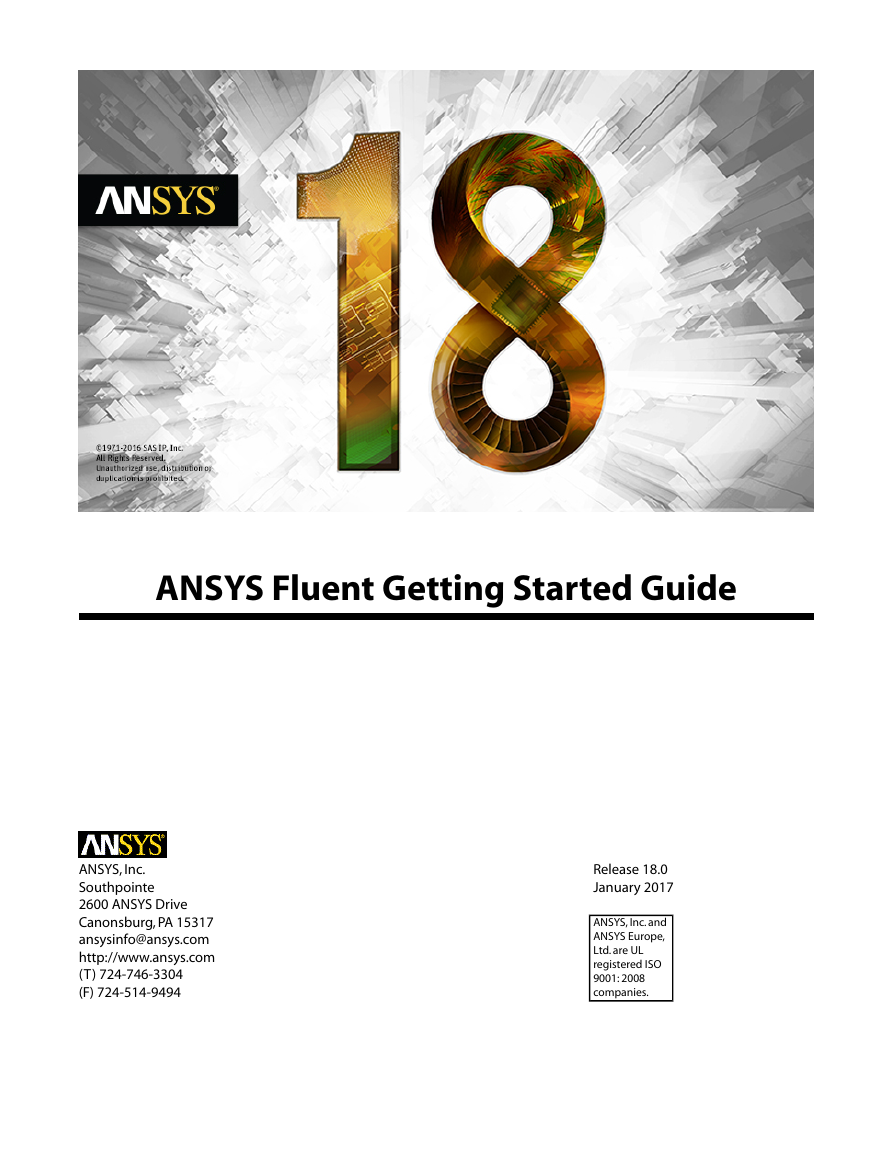
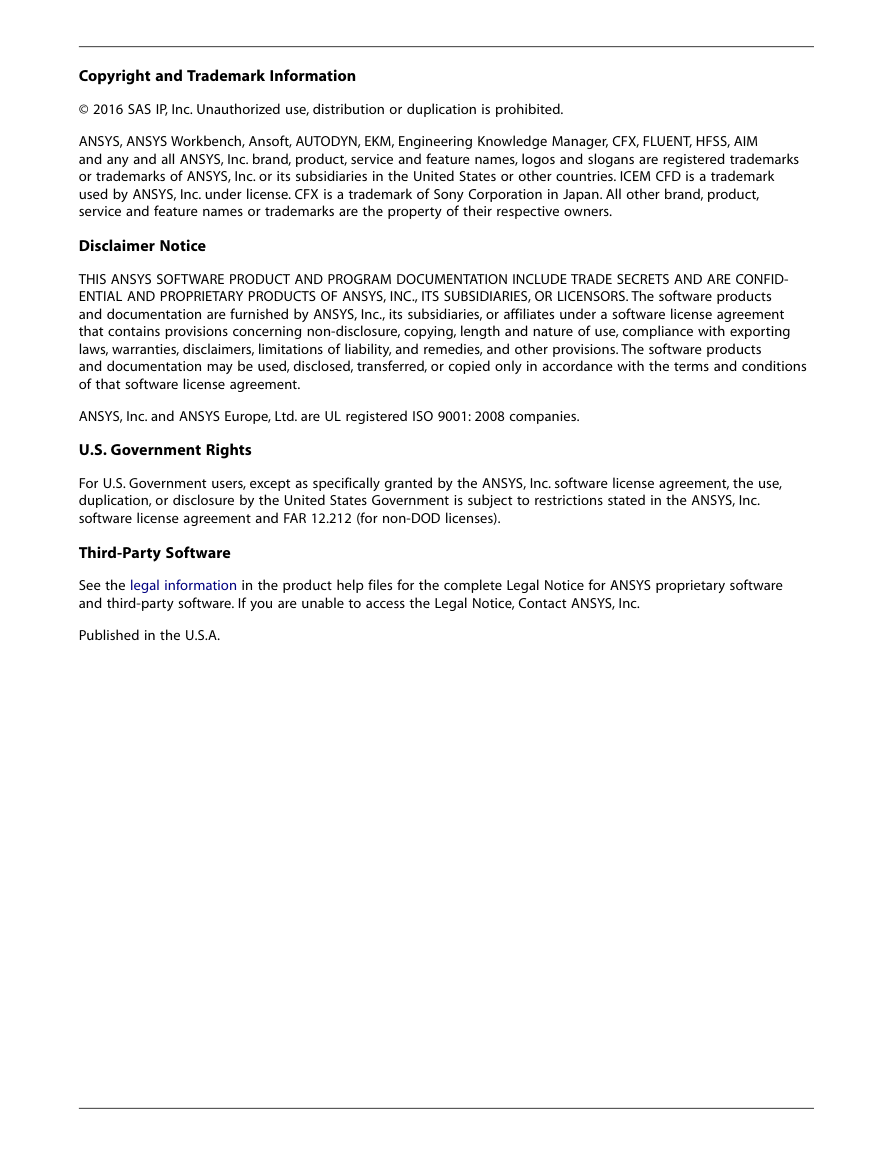
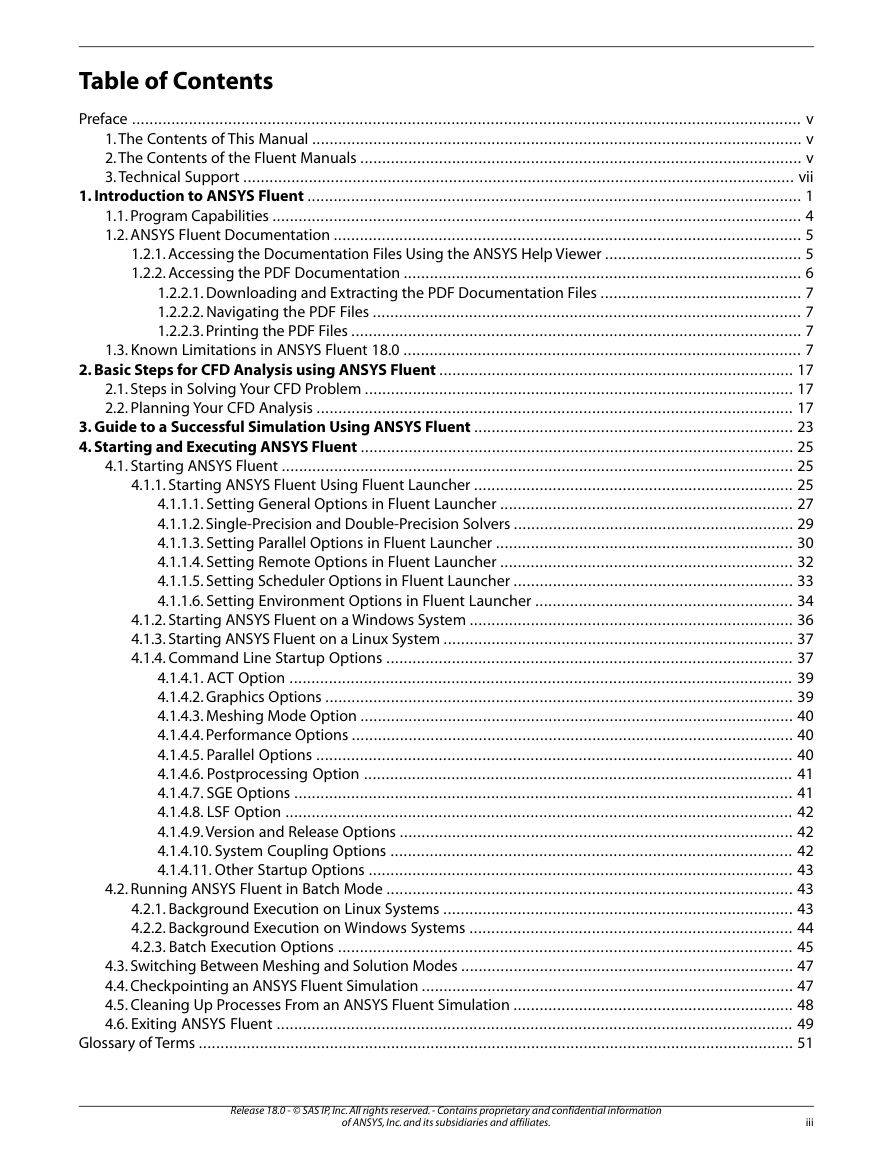

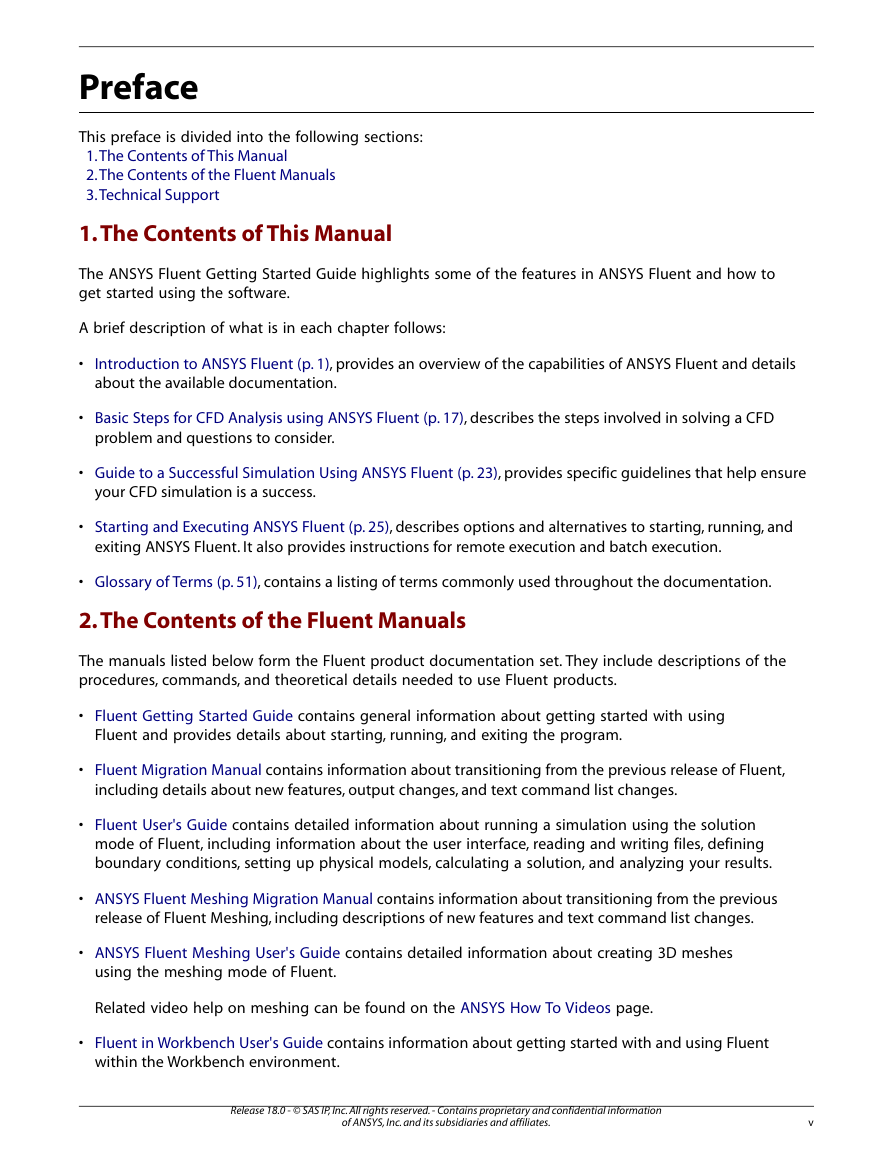

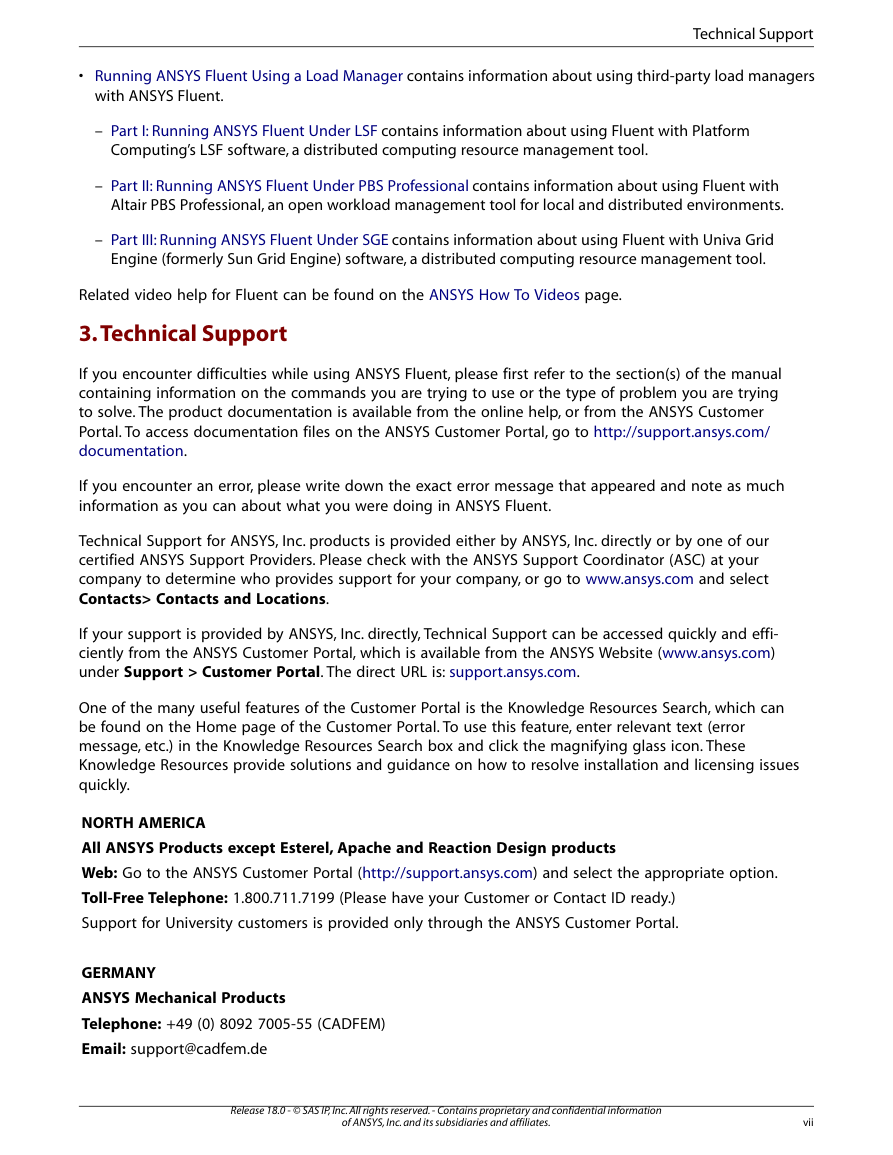
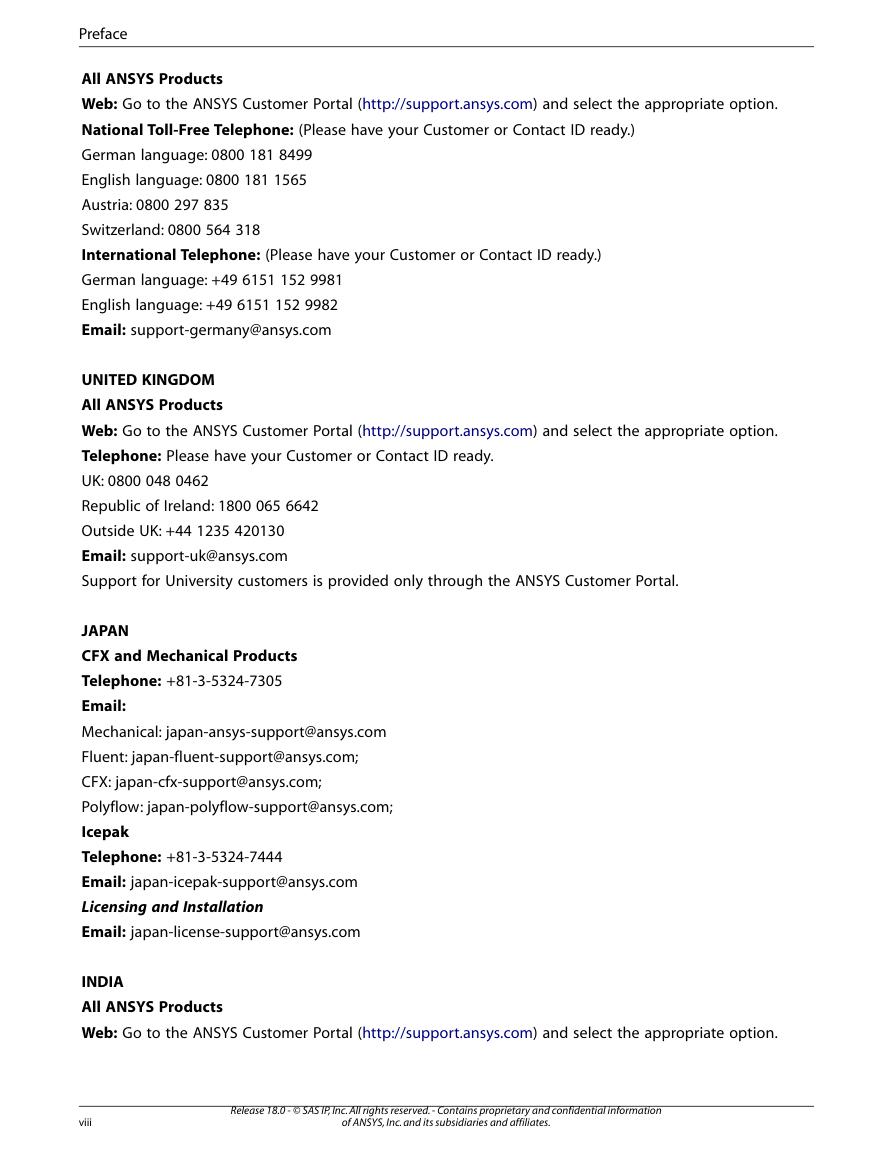








 2023年江西萍乡中考道德与法治真题及答案.doc
2023年江西萍乡中考道德与法治真题及答案.doc 2012年重庆南川中考生物真题及答案.doc
2012年重庆南川中考生物真题及答案.doc 2013年江西师范大学地理学综合及文艺理论基础考研真题.doc
2013年江西师范大学地理学综合及文艺理论基础考研真题.doc 2020年四川甘孜小升初语文真题及答案I卷.doc
2020年四川甘孜小升初语文真题及答案I卷.doc 2020年注册岩土工程师专业基础考试真题及答案.doc
2020年注册岩土工程师专业基础考试真题及答案.doc 2023-2024学年福建省厦门市九年级上学期数学月考试题及答案.doc
2023-2024学年福建省厦门市九年级上学期数学月考试题及答案.doc 2021-2022学年辽宁省沈阳市大东区九年级上学期语文期末试题及答案.doc
2021-2022学年辽宁省沈阳市大东区九年级上学期语文期末试题及答案.doc 2022-2023学年北京东城区初三第一学期物理期末试卷及答案.doc
2022-2023学年北京东城区初三第一学期物理期末试卷及答案.doc 2018上半年江西教师资格初中地理学科知识与教学能力真题及答案.doc
2018上半年江西教师资格初中地理学科知识与教学能力真题及答案.doc 2012年河北国家公务员申论考试真题及答案-省级.doc
2012年河北国家公务员申论考试真题及答案-省级.doc 2020-2021学年江苏省扬州市江都区邵樊片九年级上学期数学第一次质量检测试题及答案.doc
2020-2021学年江苏省扬州市江都区邵樊片九年级上学期数学第一次质量检测试题及答案.doc 2022下半年黑龙江教师资格证中学综合素质真题及答案.doc
2022下半年黑龙江教师资格证中学综合素质真题及答案.doc